Abstract
Economics, like behavioral psychology, is a science of behavior, albeit highly organized human behavior. The value of economic concepts for behavioral psychology rests on (1) their empirical validity when tested in the laboratory with individual subjects and (2) their uniqueness when compared to established behavioral concepts. Several fundamental concepts are introduced and illustrated by reference to experimental data: open and closed economies, elastic and inelastic demand, and substitution versus complementarity. Changes in absolute response rate are analyzed in relation to elasticity and intensity of demand. The economic concepts of substitution and complementarity are related to traditional behavioral studies of choice and to the matching relation. The economic approach has many implications for the future of behavioral research and theory. In general, economic concepts are grounded on a dynamic view of reinforcement. The closed-economy methodology extends the generality of behavioral principles to situations in which response rate and obtained rate of reinforcement are interdependent. Analysis of results in terms of elasticity and intensity of demand promises to provide a more direct method for characterizing the effects of “motivational” variables. Future studies of choice should arrange heterogeneous reinforcers with varying elasticities, use closed economies, and modulate scarcity or income. The economic analysis can be extended to the study of performances that involve subtle discriminations or skilled movements that vary in accuracy or quality as opposed to rate or quantity, and thus permit examination of time/accuracy trade-offs.
Keywords: economics, demand, elasticity, open economies, closed economies, substitutes, complements, income, reinforcer value, response rate, choice, generalized matching, discrimination, observing response
Full text
PDF

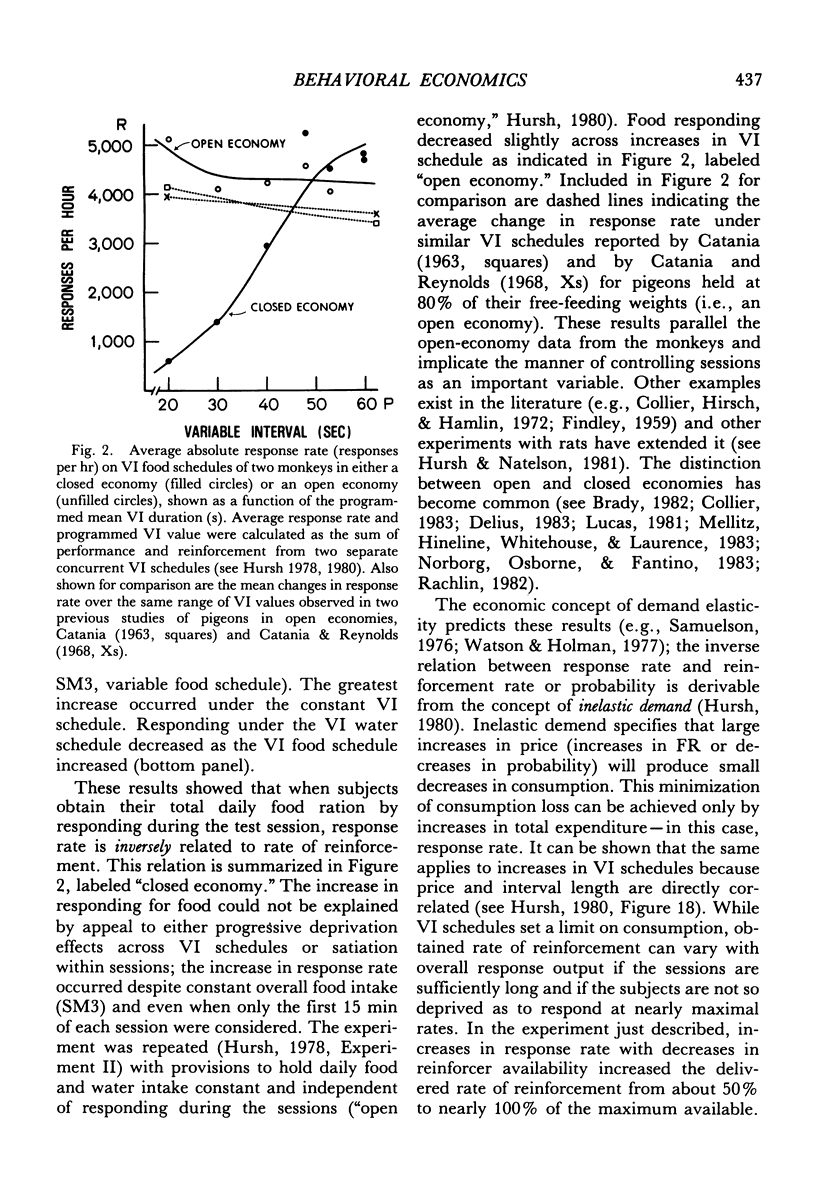
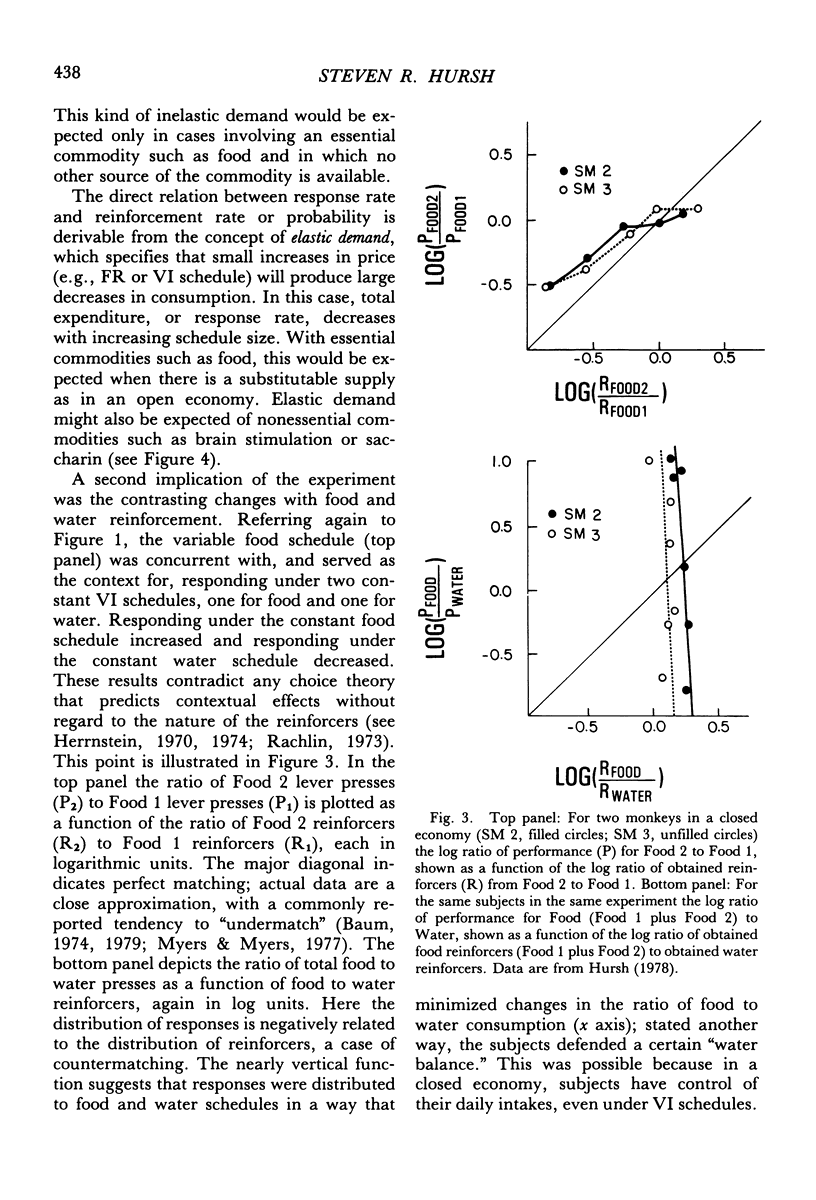
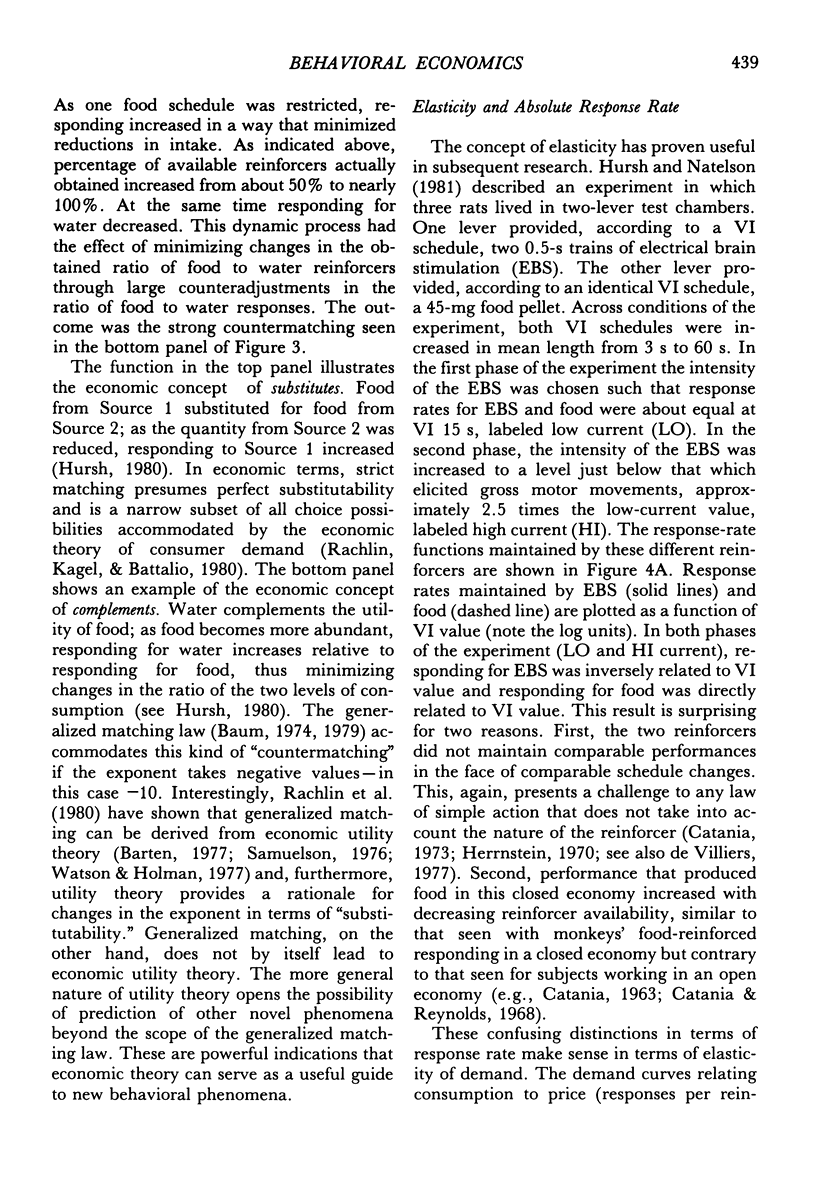









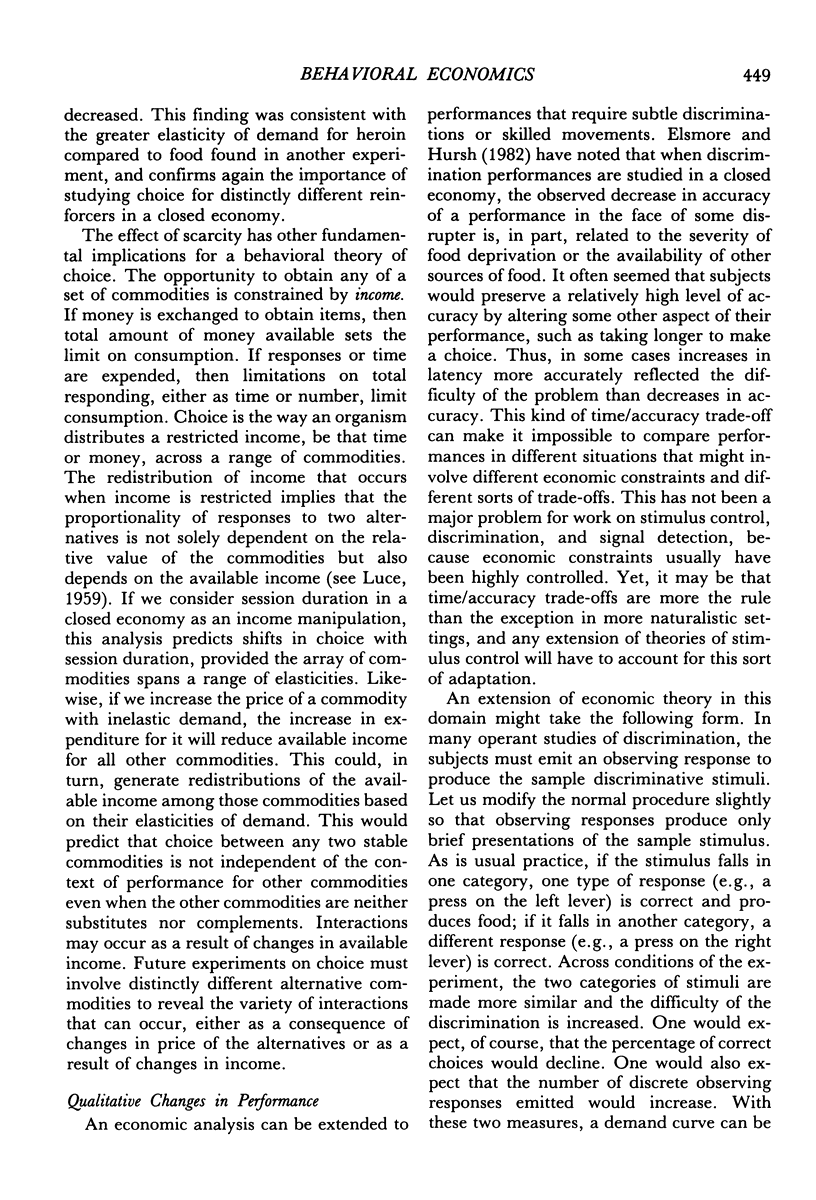


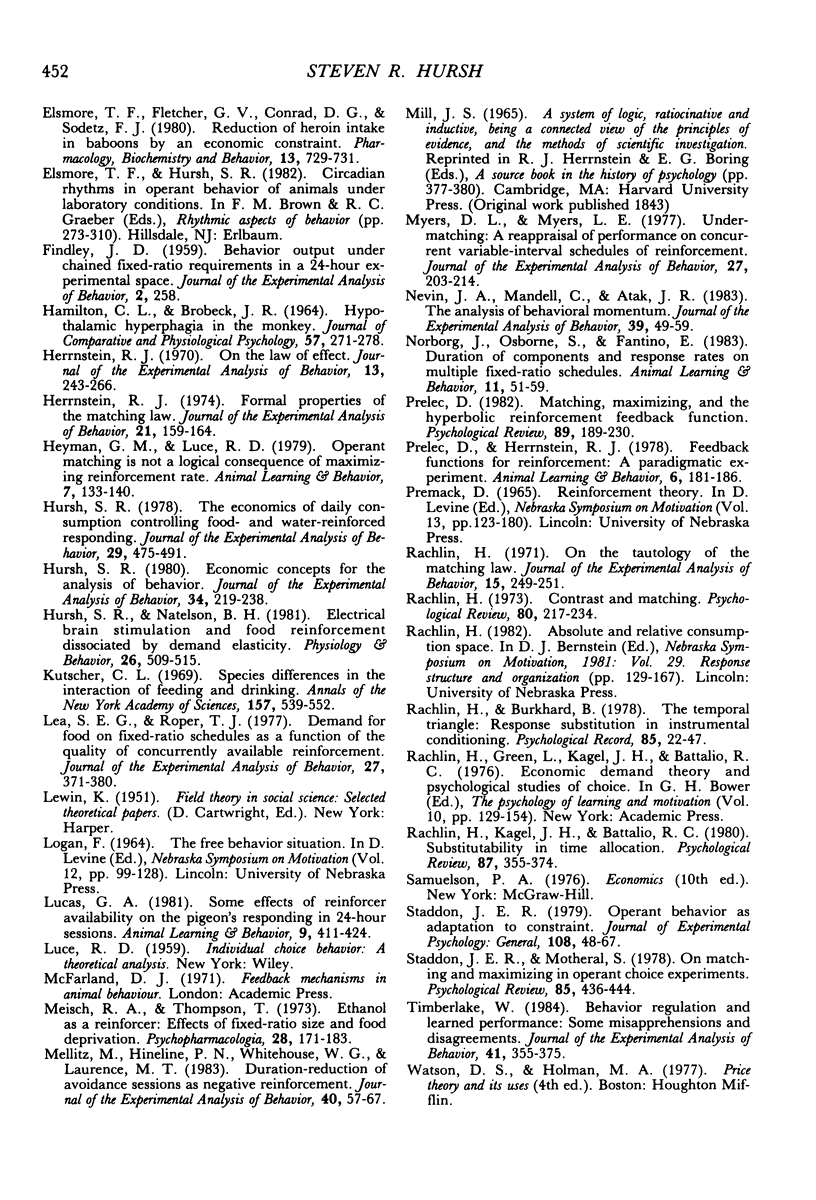
Selected References
These references are in PubMed. This may not be the complete list of references from this article.
- BOLLES R. C. The interaction of hunger and thirst in the rat. J Comp Physiol Psychol. 1961 Oct;54:580–584. doi: 10.1037/h0044595. [DOI] [PubMed] [Google Scholar]
- Baum W. M. Matching, undermatching, and overmatching in studies of choice. J Exp Anal Behav. 1979 Sep;32(2):269–281. doi: 10.1901/jeab.1979.32-269. [DOI] [PMC free article] [PubMed] [Google Scholar]
- Baum W. M. On two types of deviation from the matching law: bias and undermatching. J Exp Anal Behav. 1974 Jul;22(1):231–242. doi: 10.1901/jeab.1974.22-231. [DOI] [PMC free article] [PubMed] [Google Scholar]
- CATANIA A. C. Concurrent performances: reinforcement interaction and response independence. J Exp Anal Behav. 1963 Apr;6:253–263. doi: 10.1901/jeab.1963.6-253. [DOI] [PMC free article] [PubMed] [Google Scholar]
- Catania A. C., Reynolds G. S. A quantitative analysis of the responding maintained by interval schedules of reinforcement. J Exp Anal Behav. 1968 May;11(3 Suppl):327–383. doi: 10.1901/jeab.1968.11-s327. [DOI] [PMC free article] [PubMed] [Google Scholar]
- Catania A. C. Self-inhibiting effects of reinforcement. J Exp Anal Behav. 1973 May;19(3):517–526. doi: 10.1901/jeab.1973.19-517. [DOI] [PMC free article] [PubMed] [Google Scholar]
- Collier G., Dnarr F. Defense of water balance in the rat. J Comp Physiol Psychol. 1966 Feb;61(1):5–10. doi: 10.1037/h0022867. [DOI] [PubMed] [Google Scholar]
- Collier G., Hirsch E., Hamlin P. H. The ecological determinants of reinforcement in the rat. Physiol Behav. 1972 Nov-Dec;9(5):705–716. doi: 10.1016/0031-9384(72)90038-8. [DOI] [PubMed] [Google Scholar]
- Elsmore T. F., Fletcher G. V., Conrad D. G., Sodetz F. J. Reduction of heroin intake in baboons by an economic constraint. Pharmacol Biochem Behav. 1980 Nov;13(5):729–731. doi: 10.1016/0091-3057(80)90018-0. [DOI] [PubMed] [Google Scholar]
- HAMILTON C. L., BROBECK J. R. HYPOTHALAMIC HYPERPHAGIA IN THE MONKEY. J Comp Physiol Psychol. 1964 Apr;57:271–278. doi: 10.1037/h0039915. [DOI] [PubMed] [Google Scholar]
- Herrnstein R. J. Formal properties of the matching law. J Exp Anal Behav. 1974 Jan;21(1):159–164. doi: 10.1901/jeab.1974.21-159. [DOI] [PMC free article] [PubMed] [Google Scholar]
- Herrnstein R. J. On the law of effect. J Exp Anal Behav. 1970 Mar;13(2):243–266. doi: 10.1901/jeab.1970.13-243. [DOI] [PMC free article] [PubMed] [Google Scholar]
- Hursh S. R. Economic concepts for the analysis of behavior. J Exp Anal Behav. 1980 Sep;34(2):219–238. doi: 10.1901/jeab.1980.34-219. [DOI] [PMC free article] [PubMed] [Google Scholar]
- Hursh S. R., Natelson B. H. Electrical brain stimulation and food reinforcement dissociated by demand elasticity. Physiol Behav. 1981 Mar;26(3):509–515. doi: 10.1016/0031-9384(81)90180-3. [DOI] [PubMed] [Google Scholar]
- Hursh S. R. The economics of daily consumption controlling food- and water-reinforced responding. J Exp Anal Behav. 1978 May;29(3):475–491. doi: 10.1901/jeab.1978.29-475. [DOI] [PMC free article] [PubMed] [Google Scholar]
- Kutscher C. L. Species differences in the interaction of feeding and drinking. Ann N Y Acad Sci. 1969 May 15;157(2):539–552. doi: 10.1111/j.1749-6632.1969.tb12906.x. [DOI] [PubMed] [Google Scholar]
- Lea S. E., Roper T. J. Demand for food on fixed-ratio schedules as a function of the quality of concurrently available reinforcement. J Exp Anal Behav. 1977 Mar;27(2):371–380. doi: 10.1901/jeab.1977.27-371. [DOI] [PMC free article] [PubMed] [Google Scholar]
- Meisch R. A., Thompson T. Ethanol as a reinforcer: effects of fixed-ratio size and food deprivation. Psychopharmacologia. 1973 Jan 1;28(2):171–183. doi: 10.1007/BF00421402. [DOI] [PubMed] [Google Scholar]
- Mellitz M., Hineline P. N., Whitehouse W. G., Laurence M. T. Duration-reduction of avoidance sessions as negative reinforcement. J Exp Anal Behav. 1983 Jul;40(1):57–67. doi: 10.1901/jeab.1983.40-57. [DOI] [PMC free article] [PubMed] [Google Scholar]
- Myers D. L., Myers L. E. Undermatching: a reappraisal of performance on concurrent variable-interval schedules of reinforcement. J Exp Anal Behav. 1977 Jan;27(1):203–214. doi: 10.1901/jeab.1977.27-203. [DOI] [PMC free article] [PubMed] [Google Scholar]
- Nevin J. A., Mandell C., Atak J. R. The analysis of behavioral momentum. J Exp Anal Behav. 1983 Jan;39(1):49–59. doi: 10.1901/jeab.1983.39-49. [DOI] [PMC free article] [PubMed] [Google Scholar]
- Rachlin H. On the tautology of the matching law. J Exp Anal Behav. 1971 Mar;15(2):249–251. doi: 10.1901/jeab.1971.15-249. [DOI] [PMC free article] [PubMed] [Google Scholar]
- Timberlake W. Behavior regulation and learned performance: Some misapprehensions and disagreements. J Exp Anal Behav. 1984 May;41(3):355–375. doi: 10.1901/jeab.1984.41-355. [DOI] [PMC free article] [PubMed] [Google Scholar]


